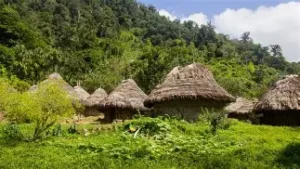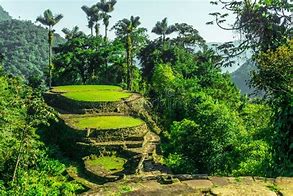
Introduction
Deep in the lush jungles of northern Colombia’s Sierra Nevada de Santa Marta, hidden beneath a thick canopy of towering trees, lies one of South America’s most fascinating archaeological treasures: Ciudad Perdida, or the Lost City.
Thank you for reading this post, don't forget to subscribe!Built around 800 CE — centuries before Machu Picchu — Ciudad Perdida is an ancient Tayrona city of stone terraces, staircases, and plazas, perched high on a mountain ridge overlooking the Caribbean coast. Once a vibrant spiritual and political center, it was abandoned and reclaimed by the jungle, remaining forgotten to outsiders until its rediscovery in the 1970s.
Today, reaching Ciudad Perdida is no small feat. The only way in is by foot — a multi-day trek through humid jungle, across rivers, and up more than 1,200 moss-covered stone steps to the city itself. But for those willing to make the journey, it’s an unforgettable adventure into Colombia’s history, biodiversity, and indigenous culture.

What is Ciudad Perdida?
Ciudad Perdida (also called Teyuna by indigenous people) is thought to have been the capital of the Tayrona civilization, which flourished in the Sierra Nevada for centuries.
Archaeologists believe the city was home to thousands of people, featuring an elaborate network of terraces, ceremonial plazas, storehouses, and homes. Connected by stone pathways and staircases, the city blends seamlessly into its mountainous jungle setting — a testament to the Tayronas’ sophisticated engineering and spiritual connection to nature.
While Spanish colonizers never found Ciudad Perdida, looters stumbled upon it in the 1970s, plundering much of its gold and ceramics before archaeologists and the Colombian government stepped in to protect it.
Why Trek to Ciudad Perdida?
A Journey Through Time and Nature
Unlike many other archaeological sites, Ciudad Perdida isn’t accessible by road or train — and that’s part of its magic. To reach it, you must traverse the same paths once walked by the Tayrona people, giving you a sense of connection to the past that’s hard to replicate elsewhere.
Immersive Jungle Experience
The trek takes you through one of the world’s most biodiverse regions: dense rainforest filled with colorful birds, butterflies, monkeys, and the constant hum of insects and rushing rivers.
Indigenous Culture
The trail passes through lands inhabited by the Wiwa, Kogi, and Arhuaco — descendants of the Tayrona — who still live in harmony with the forest. Guides often explain their customs and beliefs, offering a rare glimpse into living traditions.

The Trek: What to Expect
The trek to Ciudad Perdida is physically demanding but doable for anyone in reasonably good shape. It is typically completed as a 4- to 6-day round-trip, covering about 46–50 kilometers (28–31 miles) in total.
 Disclosure
Disclosure
As an Amazon Associate, I earn from qualifying purchases. This website also contains other affiliate links, and we may earn a small commission if you make a purchase through them — at no extra cost to you. We only recommend products and services we trust and believe will enhance your outdoor adventures. Thank you for supporting our work!
South America Adventure Gear Guide here
Discover the best drones and essential accessories to capture breathtaking landscapes, wildlife, and adventures across South America perfect for beginners and pros alike!
50 Best Drone Gear & Accessories
Drone Use: Know Before You Fly
Drone regulations vary widely depending on the location. Some parks, natural areas, and landmarks prohibit drones to protect wildlife, visitors, and sensitive environments, while others may allow them with certain restrictions or permits. Always check local, state, and federal rules before flying, respect no-fly zones, and prioritize safety, privacy, and environmental care during your adventure.
Here’s what you can expect:
Day-by-Day Overview
Day 1: Into the Jungle
- The trek begins from the small village of El Mamey, about a 3–4 hour drive from Santa Marta.
- The first day involves a steep uphill climb followed by descents into the jungle.
- You’ll pass through small farms, open hillsides, and eventually thick rainforest.
- Overnight: Campsite in hammocks or bunk beds with mosquito nets.
Day 2: Deeper Into the Sierra Nevada
- The trail becomes more rugged, crossing rivers (sometimes waist-deep) and climbing steep muddy paths.
- You’ll see waterfalls, orchids, and wildlife along the way.
- Some camps are located next to rivers where you can cool off.
Day 3: Arrival at the Lost City
- This is the most challenging yet rewarding day.
- After crossing the Buritaca River several times, you’ll reach the base of a massive stone staircase — 1,200+ steps ascending into the jungle.
- At the top: Ciudad Perdida reveals itself — a series of terraces and plazas shrouded in mist, offering breathtaking views.
- Spend time exploring the ruins with your guide, learning about the Tayrona civilization and the significance of the site.
- Overnight: Either at the campsite near Ciudad Perdida or farther back down the trail.
Day 4–6: Return to El Mamey
- The return journey retraces your steps, offering a different perspective of the landscape and time to soak in the experience.

What You’ll See at Ciudad Perdida
At the site itself, you’ll explore:
- Stone terraces & plazas: Used for homes, ceremonies, and markets.
- Stone pathways & staircases: Lined with moss and ferns, blending into the forest.
- Circular platforms: Thought to be the foundations of wooden huts and ceremonial spaces.
- Panoramic views: Overlooking the valleys and mountains of the Sierra Nevada.
The silence of the site, broken only by the sounds of the jungle, creates an almost mystical atmosphere — a stark reminder of the civilization that once thrived here.
Flora & Fauna of the Sierra Nevada
The journey isn’t just about history — the natural beauty of the Sierra Nevada is spectacular:
Lush jungle: Towering ceiba trees, strangler figs, and dense vines.
Wildlife: Howler monkeys, toucans, parrots, and iridescent butterflies.
Rivers & waterfalls: Crystal-clear streams where you can swim to cool off.
Flowers: Orchids, bromeliads, and countless other tropical blooms.
Indigenous Perspectives
For the Wiwa, Kogi, and Arhuaco people, Ciudad Perdida remains a sacred site. They continue to conduct spiritual ceremonies here, maintaining their ancestral connection to the land.
Visitors are asked to respect their customs — such as not entering certain ceremonial areas — and to listen to guides who often share stories about their worldview, which emphasizes balance between humans and nature.
Practical Tips for the Trek
Physical Preparation
✅ Be ready for long days of hiking (5–8 hours/day).
✅ Practice on steep and muddy trails before your trip.
✅ Train with a backpack to get used to carrying weight.
Packing List
Lightweight clothing that dries quickly
Long pants & sleeves (to protect from insects & sun)
Sandals or water shoes (for river crossings)
Sturdy, broken-in hiking boots
Water purification tablets or filter
Insect repellent & sunscreen
Quick-dry towel & sleeping bag liner
Camera & waterproof bag
When to Go
- The trek is possible year-round, but the dry season (December–March) is more pleasant.
- The rainy season (April–November) means muddier trails & higher rivers, but fewer crowds and a more vibrant jungle.
Food & Accommodation
- Campsites provide simple meals (rice, beans, meat, plantains, fruit).
- Sleep in hammocks or bunk beds under mosquito nets.
- Bring snacks and extra energy bars for the trail.

Challenges & Rewards
This trek is not a walk in the park. You’ll sweat, you’ll slip in the mud, and you might battle mosquitoes and heat. But the rewards — both physical and emotional — are immense:
A deeper connection to nature.
Immersion in one of the world’s richest ecosystems.
The pride of reaching a remote and sacred site few have seen.
Many trekkers describe the experience as life-changing — not just because of the destination, but because of the journey itself.
Responsible Tourism
By choosing a licensed tour operator and traveling responsibly, your visit supports conservation and local communities.
✅ Stay on marked paths to prevent erosion.
✅ Carry out all trash.
✅ Respect indigenous traditions & areas.
✅ Choose tours that employ indigenous guides & use eco-friendly practices.
Beyond the Trek: Other Things to Do Nearby
If you have extra time in the region, consider exploring:
- The beaches of Parque Nacional Natural Tayrona — pristine Caribbean shores at the foot of the mountains.
- The colonial charm of Santa Marta — Colombia’s oldest city.
- Mountain biking or birdwatching tours in Minca, a laid-back town in the Sierra Nevada foothills.
Conclusion
Trekking to Ciudad Perdida is much more than a hike — it’s a journey into Colombia’s past, through its breathtaking natural beauty, and into the heart of its indigenous heritage.
With every step through the humid jungle, every river crossed, and every mossy stone climbed, you’ll feel the weight of history and the pulse of life that still beats in these mountains.
If you’re looking for an adventure that challenges you physically, immerses you in nature, and connects you with ancient culture, the Lost City awaits.
Strap on your boots, pack your sense of wonder, and set off toward the misty mountains of Colombia — to discover what’s been hidden for centuries. ✨
 Explore More Adventure Hubs:
Explore More Adventure Hubs:
Leave a Reply